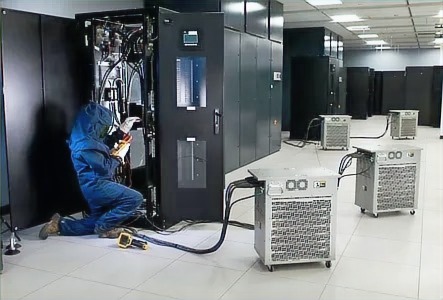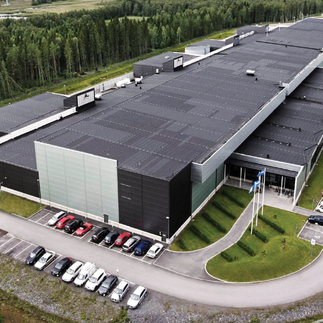The Future of Data Centers: Building and Decommissioning
- Platocom

- May 16, 2024
- 4 min read
Updated: May 17, 2024
As data demand rises, building new data centers is crucial. Equally vital is decommissioning outdated hardware in existing centers.
Understanding the full lifecycle of data centers—from planning and building to operating and decommissioning—is essential for effective IT management. As the sheer volume of data and the demand for services grow, so does the need to build new data centers. However, an equally important aspect is data center decommissioning, which is becoming increasingly essential as companies upgrade obsolete hardware to maintain their competitive edge.
For this week's blog, Platocom chose to write about data center decommissioning to bring a balance to the narrative. Decommissioning is not just about shutting down and dismantling facilities; it’s about evolving and adapting to the changing technological landscape.
Outdated Data Centers vs Surge in Demand for New Data Centers
The surge in demand for data centers has captured the attention of a wide range of investors, including those in growth capital, buyouts, real estate, and increasingly, infrastructure. However, managing cross connects—connections that link networks within or between data centers (new or old)—remains essential during both the expansion and decommissioning processes. Proper handling of these connections ensures a smooth transition and maintains network integrity. For more insights, check out our blog post about the crucial role of cross connects in data centers here.
Data center decommissioning is the process of securely deconstructing a data center to upgrade or retire it.
The Importance of Decommissioning
Data center decommissioning involves eliminating hardware for relocation, resale, disposal, or recycling while rerouting data to new servers. It requires meticulous planning and careful execution to protect valuable and sensitive data. The process includes more than just dismantling hardware and installing new servers. IT administrators should start with a detailed Decommission Project Plan and a Decommissioning Checklist to ensure a smooth transition without disrupting business operations.
Most discussions focus on the expansion of the data center "corridor." The surge in demand for data centers has captured the attention of a wide range of investors, including those in growth capital, buyouts, real estate, and increasingly, infrastructure. However, managing cross connects—connections that link networks within or between data centers—remains essential during both the expansion and decommissioning processes. Proper handling of these connections ensures a smooth transition and maintains network integrity. For more insights, check out our blog post about the crucial role of cross connects in data centers here.
Decommissioning old or redundant centers optimizes resources and maintains operational efficiency.
While the industry often focuses on the expansion and innovation of new data centers, addressing decommissioning is vital for several reasons:
Cost Efficiency: Decommissioning outdated data centers can significantly reduce operational and maintenance costs.
Energy Consumption: Data centers consume significant amounts of energy. Decommissioning outdated or inefficient centers reduces overall energy consumption, which is beneficial for the environment and aligns with sustainability goals.
Risk Management:
Reduced Downtime and Failures: Aging data centers are more prone to hardware failures and outages. Decommissioning reduces the risk of unexpected downtimes that can disrupt business operations.
Disaster Recovery: Modern solutions often provide better disaster recovery capabilities compared to old, on-premises data centers.
Data Security: Proper decommissioning ensures that data is securely erased or destroyed, preventing data breaches and unauthorized access. This is critical for maintaining the confidentiality and integrity of sensitive information.
Environmental Responsibility: Properly decommissioning and disposing of obsolete equipment minimizes e-waste and reduces environmental impact.
Transition to Advanced Technologies: With the rapid advancement of technology, newer data centers are often far more efficient and powerful than their predecessors. Decommissioning older facilities allows organizations to transition to more advanced technologies, staying competitive and innovative without the burden of maintaining outdated infrastructure.
Understanding Data Center Decommissioning

Data center decommissioning refers to the process of retiring a data center from service. This can be due to various reasons such as transitioning to cloud services (link to last blog), consolidating multiple data centers, upgrading to newer technology, or business mergers and acquisitions. Proper decommissioning is essential to prevent data breaches, minimize environmental impact, and comply with regulatory requirements. It involves securely removing and disposing of data, dismantling physical infrastructure, and ensuring that all operations are safely concluded.
Challenges in Data Center Decommissioning
Decommissioning a data center can present several challenges:
Data Migration Issues: Ensuring data integrity and availability during migration can be complex, especially with large volumes of data.
Regulatory Compliance: Navigating different regulatory requirements and ensuring compliance can be daunting.
Physical Dismantling: Safely dismantling and disposing of equipment requires specialized knowledge and resources.
Mitigating these challenges involves careful planning, engaging experienced professionals, and utilizing reliable tools and methodologies.
Best Practices for Successful Decommissioning
To ensure a smooth decommissioning process, follow these best practices:
Engage Experienced Professionals: Work with experts who have experience in data center decommissioning. Their knowledge and skills can help navigate complex challenges. Contact Platocom today for a quote.
Regular Communication: Keep all stakeholders informed throughout the decommissioning process. Regular updates and clear communication help manage expectations and prevent misunderstandings.
Post-Decommissioning Audits: Conduct thorough audits after the decommissioning process to ensure that all steps were completed correctly and that no sensitive data remains.
Cross Connects in Data Center Decommissioning
Inventory and Documentation: Compile detailed records of cross connects, aiding effective planning.
Impact Assessment: Identify dependent services and systems to mitigate disruptions.
Migration Planning: Coordinate with stakeholders for seamless service transition.
Disconnection and Re-routing: Execute careful disconnection to avoid disruptions.
Physical Removal: Dispose of equipment responsibly to prevent data breaches.
Verification and Testing: Ensure proper migration and functionality post-decommissioning.
Documentation and Reporting: Maintain updated records for future reference and audits.
Final Thoughts
Decommissioning is not just about shutting down facilities; it’s about evolving and adapting to technological changes, paving the way for a more sustainable and efficient digital infrastructure.
Call to Action
If you're planning to decommission a data center or need assistance with the process, our team of experts is here to help. Contact us for a consultation or to learn more about our decommissioning services. Let's ensure your data center is decommissioned safely and responsibly.




















Great blog! I appreciate how you emphasize the importance of data center decommissioning as part of the overall lifecycle. It’s crucial for organizations to not only focus on building and operating but also on the responsible dismantling of outdated facilities. This proactive approach not only helps in maintaining competitive advantage but also aligns with sustainability goals. Understanding this balance is key in today’s fast-paced tech environment. Looking forward to more insights on evolving best practices in IT management!